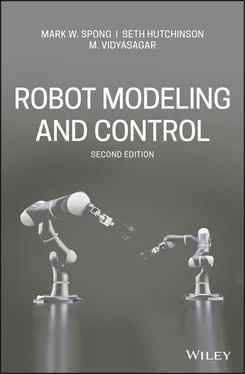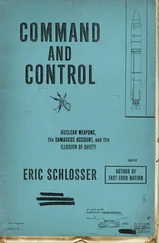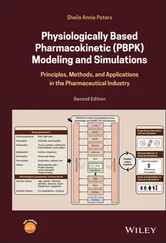Chapter 10 treats the force control problem. Both impedance control and hybrid control are discussed. We also present the lesser known hybrid impedance control method, which allows one to control impedance and regulate motion and force at the same time. To our knowledge this is the first textbook that discusses the hybrid impedance control approach to robot force control.
Chapter 11is an introduction to visual servo control, which is the problem of controlling robots using feedback from cameras mounted either on the robot or in the workspace. We present those aspects of vision that are most useful for vision-based control applications, such as imaging geometry and feature extraction. We then develop the differential kinematics that relate camera motion to changes in extracted features and we discuss the main concepts in visual servo control.
Chapter 12is a tutorial overview of geometric nonlinear control and the method of feedback linearization of nonlinear systems. Feedback linearization generalizes the methods of computed torque and inverse dynamics control that are covered in Chapters 8 and 9. We derive and prove the necessary and sufficient conditions for local feedback linearization of single-input/single-output nonlinear systems, which we then apply to the flexible joint control problem. We also introduce the notion of nonlinear observers with output injection.
Part IVis a completely new addition to the second edition and treats the control problems for underactuated robots and nonholonomic systems.
Chapter 13deals with underactuated serial-link robots. Underactuation arises in applications such as bipedal locomotion and gymnastic robots. In fact, the flexible-joint robot models presented in Chapters 8 and 12 are also examples of underactuated robots. We present the ideas of partial feedback linearization and transformation to normal forms, which are useful for controller design. We also discuss energy and passivity methods to control this class of systems.
Chapter 14deals primarily with wheeled mobile robots, which are examples of systems subject to nonholonomic constraints. Many of the control design methods presented in the chapters leading up to Chapter 14do not apply to nonholonomic systems. Thus, we cover some new techniques applicable to these systems. We present two fundamental results, namely Chow’s theorem and Brockett’s theorem, that provide conditions for controllability and stabilizability, respectively, of mobile robots.
Finally, the appendices have been expanded to give much of the necessary background mathematics to be able to follow the development of the concepts in the text.
A Note to the Instructor
This text is suitable for several quarter-long or semester-long courses in robotics, either as a two- or three- course sequence or as stand-alone courses. The first five chapters can be used for a junior/senior-level introduction to robotics for students with at least a minimal background in linear algebra. Chapter 8may also be included in an introductory course for students with some exposure to linear control systems. The independent joint control problem largely involves the control of actuator and drive-train dynamics; hence most of the subject can be taught without prior knowledge of Euler–Lagrange dynamics.
A graduate-level course on robot dynamics and control can be taught using all or parts of Chapters 6 through 12.
Finally, one or more special topics courses can be taught using Chapters 9 through 14. Below we outline several possible courses that can be taught from this book:
Course 1: Introduction to Robotics
Level: Junior/Senior undergraduate
For a one quarter course (10 weeks):
Chapter 1: Introduction
Chapter 2: Rigid Motions and Homogeneous Transformations
Chapter 3: Forward Kinematics
Chapter 4: Velocity Kinematics and Jacobians
Chapter 5: Inverse Kinematics
For a one semester course (16 weeks) add:
Chapter 7: Motion Planning and Trajectory Generation
Chapter 8: Independent Joint Control
Course 2: Robot Dynamics and Control
Level: Senior undergraduate/graduate
For a one quarter course (10 weeks):
Chapters 1–5: Rapid Review of Kinematics (selected sections)
Chapter 6: Dynamics
Chapter 7: Path and Trajectory Planning
Chapter 9: Nonlinear and Multivariable Control
Chapter 10: Force Control
For a one semester course (16 weeks) add:
Chapter 11: Vision-Based Control
Chapter 12: Feedback Linearization
Course 3: Advanced Topics in Robot Control
Level: Graduate
For a one semester course (16 weeks):
Chapter 6: Dynamics
Chapter 7: Motion Planning and Trajectory Generation
Chapter 9: Nonlinear and Multivariable Control
Chapter 11: Vision-Based Control
Chapter 12: Feedback Linearization
Chapter 13: Underactuated Robots
Chapter 14: Mobile Robots
The instructor may wish to supplement the material in any of these courses with additional material to delve deeper into a particular topic. Also, either of the last two chapters can be covered in Course 2 by eliminating the Force Control chapter or the Vision-Based Control chapter.
Acknowledgements
We would like to offer a special thanks to Nick Gans, Peter Hokayem, Benjamin Sapp, and Daniel Herring, who did an outstanding job of producing most of the figures in the first edition, and to Andrew Messing for figure contributions to the current edition. We would like to thank Francois Chaumette for discussions regarding the formulation of the interaction matrix in Chapter 11and to Martin Corless for discussion on the robust control problem in Chapter 9. We are indebted to several reviewers for their very detailed and thoughtful reviews, especially Brad Bishop, Jessy Grizzle, Kevin Lynch, Matt Mason, Eric Westervelt. We would like to thank our students, Nikhil Chopra, Chris Graesser, James Davidson, Nick Gans, Jon Holm, Silvia Mastellone, Adrian Lee, Oscar Martinez, Erick Rodriguez, and Kunal Srivastava, for constructive feedback on the first edition.
We would like to acknowledge Lila Spong for proofreading the manuscript of the second edition, and also the many people who sent us lists of typographical errors and corrections to the first edition, especially Katherine Kuchenbecker and her students, who provided numerous corrections.
Mark W. Spong
Seth Hutchinson
M. Vidyasagar
Robotics is a relatively young field of modern technology that crosses traditional engineering boundaries. Understanding the complexity of robots and their application requires knowledge of electrical engineering, mechanical engineering, systems and industrial engineering, computer science, economics, and mathematics. New disciplines of engineering, such as manufacturing engineering, applications engineering, and knowledge engineering have emerged to deal with the complexity of the field of robotics and factory automation. More recently, mobile robots are increasingly important for applications like autonomous vehicles and planetary exploration.
This book is concerned with fundamentals of robotics, including kinematics, dynamics, motion planning, computer vision, and control. Our goal is to provide an introduction to the most important concepts in these subjects as applied to industrial robot manipulators, mobile robots and other mechanical systems.
The term robotwas first introduced by the Czech playwright Karel Čapek in his 1920 play Rossum’s Universal Robots, the word robotabeing the Czech word for worker. Since then the term has been applied to a great variety of mechanical devices, such as teleoperators, underwater vehicles, autonomous cars, drones, etc. Virtually anything that operates with some degree of autonomy under computer control has at some point been called a robot. In this text we will focus on two types of robots, namely industrial manipulators and mobile robots.
Читать дальше












